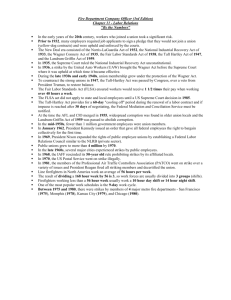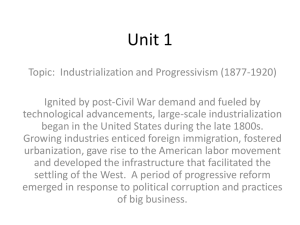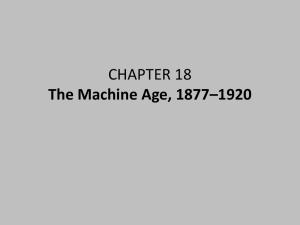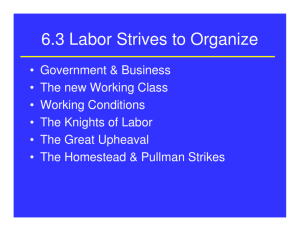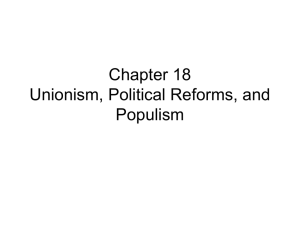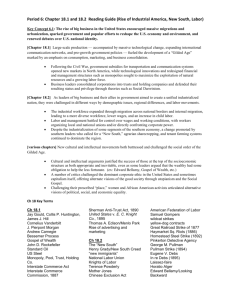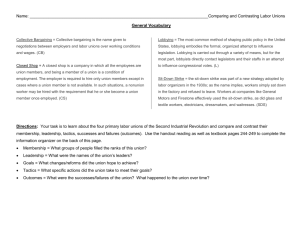Response to Industrialization
advertisement
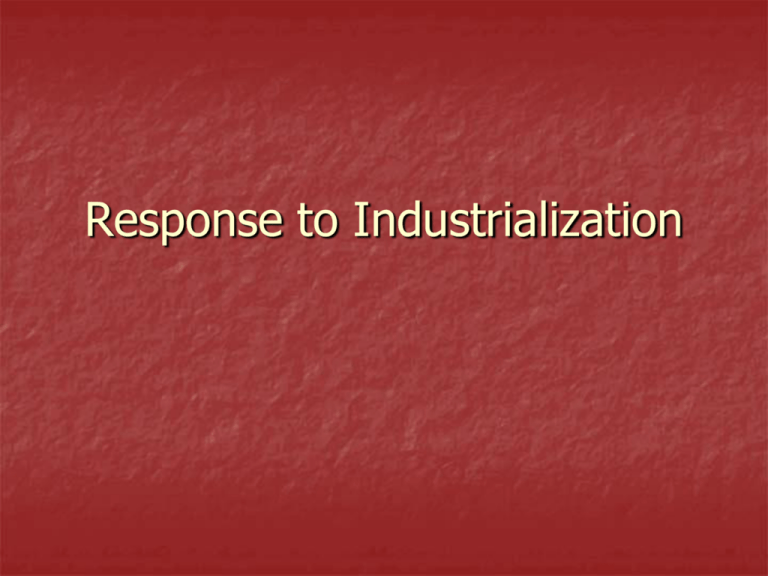
Response to Industrialization Change in the Workforce Rise in Big. Biz = fewer people self- employed. More & More wage earners. They come from: A. People leaving farms. B. “new “ Immigrants (Eastern and Southern Europe) & Chinese. Less skilled jobs (more “unskilled”) More women and Children in the workforce. “New” Immigrants From Eastern And Southern Europe Jews and Catholics Bad Working Conditions Early Industrial Workplace is usually unsafe. Hours long (10-12 hr. workdays). Wages low. Coal Miners One of the worst jobs! Low pay and very dangerous and harmful to one’s health. Company Towns Workers live in houses owned by the company they work for. “Company Store.” Often paid in “scrip” Company Town If you were a worker in the Gilded Age, what would you do to get better wages and working conditions? Organization of Labor Workers organized Unions to get better pay, shorter work days, better work conditions. Union = group that represents workers. Use Strikes and Boycotts when necessary. Most early strikes result in violence Business responds with: A. “lockouts.” B. Yellow Dog Contracts C. “Pinkertons” D. Blacklists E. “scabs” Public Response to Early Unions Most people blame unions—rather than business owners—for violence. Some union members (especially new immigrants) are anarchists or socialists. State and federal govt. send police/military to stop strikes. Anarchists = people who want to destroy society so it can be remade from scratch to form a more fair and just society. Feel that it is okay to use violence to achieve goals. Socialists = people who want the government to own big businesses so that workers wont be exploited and businesses are run for the public good rather than for profit. Capitalism = Businesses are privately owned and are run for profit. STOP Stop—have do cartoons (go over in class) Do pri. Sources of unions as homework Thur = union chart and labor incident chart. Day 2 Early Labor Struggles Homestead Reading What action (after the building of the wall) was taken by Frick that started a confrontation with the workers? How did violence start? Who won the labor struggle at Homestead? The company or the wokrers? The First National Unions National Labor Union (NLU) is the first. Want an 8-hour work day. Want restrictions on immigration (especially Chinese). Not very successful, and they fall apart when their leader dies. Molly Maguires Militant Labor Organization of Irish immigrants in coal region of Pennsylvania. Used terrorist tactics—violence & murder. Helped lead to public perception that unions were dangerous radicals. Much of the violence attributed to the Mollys was really performed by people hired by the mine owners to discredit them. The Great Railroad Strike 1877 First national labor conflict 10% wage cut for Eastern RR employees. There are strikes and violence. State militias called out. Pres. Hayes sends federal troops into W.Virginia. Over 100 people are killed. Strike ends after a few weeks—bad for labors reputation. Great Railroad Strike of 1877 The Knights of Labor Founded in 1869 by Philadelphia tailors. Open to all workers both skilled and unskilled, black and white, & Women. Leader is Terence Powderly. A big organizer is Mary Harris “Mother” Jones. “Mother” Jones Do primary source What the Knights are for: 1. = pay for women. 2. End to child labor. 3. Graduated Income Tax. 4. Co-op ownership of factories, mines, and other businesses. 5. They recruit blacks and women (although in the South they are segregated). 6. They want limits on immigration (especially Chinese) Haymarket Riot. 1886—Police kill 4 protesters who are striking the McCormick Harvester factory in Chicago. 1,000 workers then turn out for a rally at Haymarket Square. During the rally, someone throws a bomb and it kills 8 police officers and injures others. The police then fire into the crowd killing 10 and wounding others. 8 of the organizers of the rally were put on trial for murder and 4 were hung. 1 killed self. 3 others eventually pardoned by gov. Haymarket Fall of the Knights of Labor Haymarket (and other violence around strikes) discredits them. People begin to associate Knights with anarchists and socialists. Rise of a new Union for skilled workers (AFL). The American Federation of Labor (AFL) Led by Samuel Gompers. Is only open to “skilled” workers. Does not call for joint ownership, but increased benefits, better hours and wages. Less antagonistic towards management. IWW (a.k.a. “Wobblies”) Industrial Workers of the World Leader was “Big” Bill Haywood. Most radical union. Want socialism OK using violence Other strikes/violence The Homestead strike —1892 workers in Homestead, Penn. Are striking against a Carnegie plant. Carnegie hires 300 “Pinkertons” and eventually violence breaks out and several people are killed. Pullman Strike —1894 Pullman workers go on strike when their wages are cut (but not their rents at the company town). Eventually strike goes national and is led by Eugene V. Debs (head of the ARU). There is much violence between “guards” and strikers and many train cars are set on fire and destroyed. The government issues an injunction to stop the strike and Debs is put in jail. Eugene Debs Head of the American Railroad Union Later becomes a socialist and runs for president 4 times. Problems with early Unions Mainly open to only skilled workers. Many did not allow women or blacks (especially in the South). Many had hostility to “New “ immigrants who made up a significant part of the industrial workforce. Views of Unions Government supported business owners and often sent in police or national guard troops to stop strikes. Most upper and middle-class people were against unions. Think they are mainly anarchists and socialists and blamed them (rather than the business owners) for violence during strikes. They think unions are un-American. To address the poor working conditions, long hours, and low pay of early industrialization, workers (labor) begin to organize. Who is the little man on his knees? What do the big men standing represent? What does the title mean? What is the message of the cartoon? The First National Unions National Labor Union (NLU) is the first. Want an 8-hour work day. Want restrictions on immigration (especially Chinese). Not very successful, and they fall apart when their leader dies. http://law2.umkc.edu/faculty/projects/ftrial s/haymarket/altgeldcartoon.jpg Who are the 3 figures in the cartoon? What is the message of the cartoon? Is it pro labor or owners?

